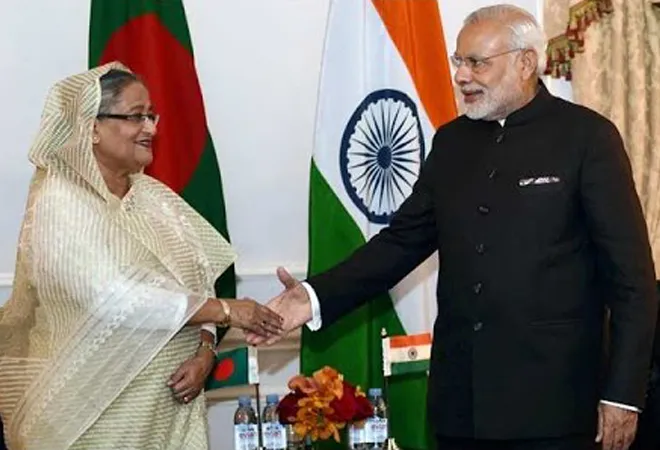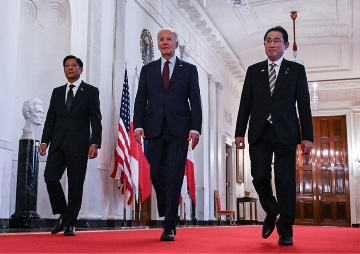
The virtual meeting between Prime Minister Narendra Modi and his Bangladesh counterpart, Prime Minister Sheikh Hasina, on 17 December showcases the special bond that the two countries share. The meeting comes just a day after the Victory Day celebration (16 December), the day Bangladesh attained victory over Pakistani forces in the 1971 Liberation War — a shared heritage between the two countries as India lent its boots during the Bangladeshi struggle for independence. The Liberation War has been foundational to the India and Bangladesh friendship, which has withstood the test of time over the past 50 years. Notably, the premiers of the two South Asian neighbours are meeting for the first bilaterally, after Prime Minister Narendra Modi’s visit to Dhaka in March this year was postponed due to the outbreak of COVID-19. The meeting will add new momentum to the relationship and is likely to give a direction to the bilateral ties for addressing the challenges of a post-pandemic world.
The India and Bangladesh relationship is considered to be a copybook example of a neighbourly relationship. India considers Bangladesh a close partner in its neighbourhood first policy, its major outreach to the countries within its immediate vicinity. In the past the few years, there have been a series of high-level visits, starting with Prime Minister Sheikh Hasina’s visit in 2010 and followed by her visits in 2017 and 2019. Indian leaders also reciprocated with Prime Minister Manmohan Singh visiting Bangladesh in 2011 and his successor Prime Minister Modi visiting in 2015. Prime Minister Modi is expected to visit Bangladesh to join the golden jubilee celebration of Bangladesh’s independence in March 2021.
The India and Bangladesh relationship is considered to be a copybook example of a neighbourly relationship.
These visits showcase the importance the leaders of the two countries give to the relationship and have contributed to strengthening cooperation in various fields. Notably, the joint communique issued after Prime Minister Hasina’s visit in 2010 played a significant role in setting the present trajectory of the relationship. The annual consultation between foreign ministers of the two countries to supervise the development of the relationship is an outcome of the visit. Again, the development partnership — which is a crucial part of the bilateral engagements — got a major push during Prime Minister Manmohan Singh’s visit as India gave US$1 billion to Bangladesh as a line of the credit. Today, India is a major development partner in Bangladesh with a promised assistance of US$10 billion.
The success of any high-level interaction between India and Bangladesh is always measured in the level of tangibles. The virtual summit will not be an exception. According to the press release issued by the Minister of External Affairs during the meeting, the leaders of the two countries are likely to discuss a wide spectrum of issues including ways to further strengthen cooperation in the post-COVID era. Some of the areas expected to get prominence are connectivity, infrastructure, development partnerships, amongst others. In this regard, a 12-km Chilahati-Haldibari rail link will be jointly inaugurated by the two prime ministers — making it the 5th railway link between the two countries. Besides, a mechanism to oversee projects under concessional Lines of Credit (LoCs) of nearly US $10 billion from India in 2017 will be discussed. Bangladesh’s Foreign Minister, A.K. Abdul Momen, however, informed that issues like water sharing agreement on the Teesta, which has been pending since 2011; and the killing of Bangladeshi nations by BSF at the border, who are primarily cattle smugglers or trespassers, will be raised by Prime Minister Hasina.
Given the depth of the India-Bangladesh ties, frequent interaction amongst top leadership on any medium, be it virtual or face-to-face, is encouraging.
India and Bangladesh are two countries bound together with the commonality of history, geography, language and culture. Given the commonalities and bonds they share, there will be a plethora of issues between the two countries like any other neighbours. The two countries have not allowed these issues to hijack the feelings of bonhomie and friendship and has not taken away from the emphasis on amicably resolving their differences. The resolution of the land boundary has been a major outcome of this approach. However, occasionally there have been spells of misunderstanding. For instance, India’s enactment of the Citizenship Amendment Act with some in Bangladesh expressing resentment, but such moments could not erase the feeling of cooperation that defines the relationship. Given the depth of the India-Bangladesh ties, frequent interaction amongst top leadership on any medium, be it virtual or face-to-face, is encouraging.
Given that geo-strategy and geo-economics is expected to face a transformation as an outcome of the pandemic, it will be pertinent for the summit to include possible areas of cooperation in the post-COVID-19 world order. An important task beforehand will be identifying the complementarities existing between the two countries and exploring modalities for exploiting them for each other’s benefit. India and Bangladesh working together could shape a new South Asia.
The views expressed above belong to the author(s). ORF research and analyses now available on Telegram! Click here to access our curated content — blogs, longforms and interviews.




 PREV
PREV


